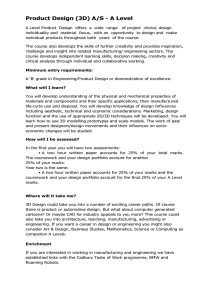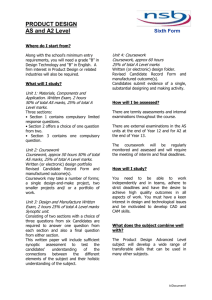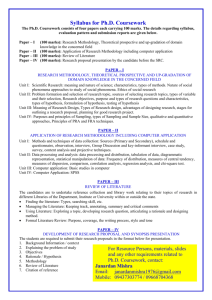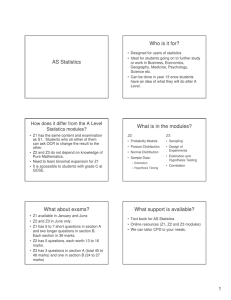Marking Coursework MEI Conference June 2009
advertisement
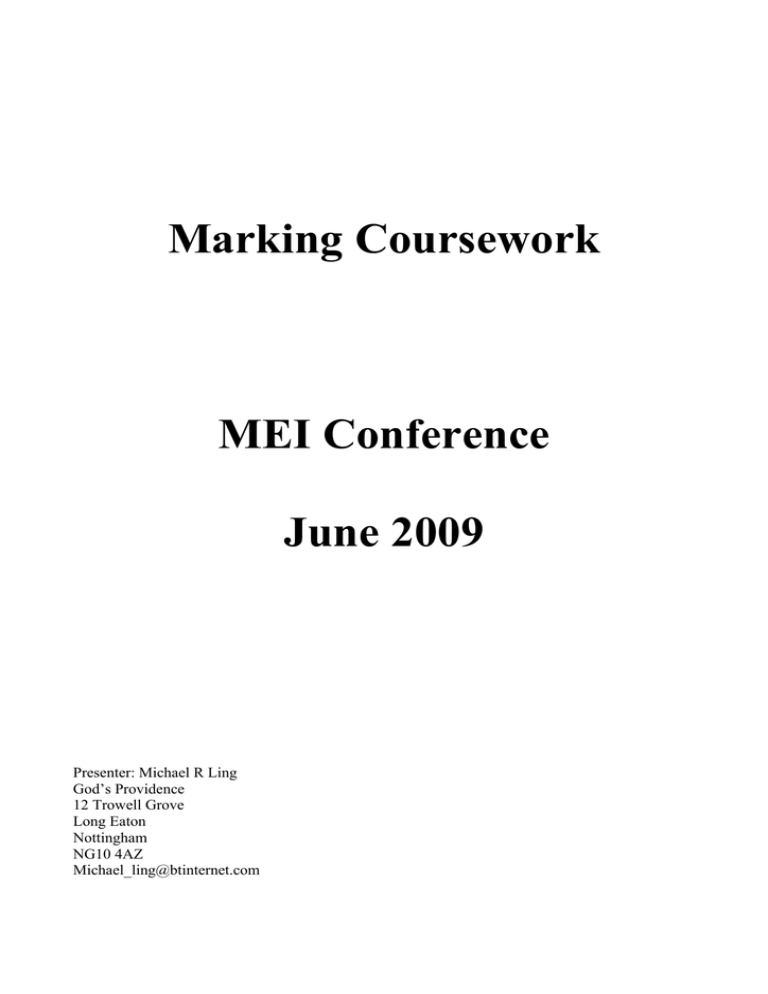
Marking Coursework MEI Conference June 2009 Presenter: Michael R Ling God’s Providence 12 Trowell Grove Long Eaton Nottingham NG10 4AZ Michael_ling@btinternet.com Coursework Coursework is work done during the course. It is also defined within Structured Mathematics as work that is assessed by the Centre. The aim of the coursework is to enable students to appreciate the practical nature of their mathematics. It will enable them to undertake work of an extended nature that can be assessed in a way not possible within a formal examination. There is now only three pieces of coursework, attached to Core C3 (4753), Numerical Methods (4776) and Differential Equations (4758) • The centre is responsible for the work. • The centre is responsible for authenticating the work as that of the candidate. • The centre is responsible for marking the coursework. • The centre is responsible for producing a valid order of merit. In other words the centre has to produce a “valid” rank order of marks. This means that the centre is responsible for internal moderation. COP81. The Examining Board will require centres to standardise assessments across different teachers and teaching groups to ensure that, in relation to a particular specification, that all candidates in the centre have been judged against the same standards and to produce a rank order of candidates for the centre as a whole/ The centre is responsible for the work. This means that it is the responsibility of the centre to ensure that the right opportunities to produce the work are given, that they set the appropriate deadlines for submission, that they set up the appropriate assessment and internal moderation procedures and submit the marks to the board. The centre is responsible for authenticating the work as that of the candidate. It is important that the work is that of the candidate. The role of the external moderator cannot include checks on the authenticity of the work. (It is sometimes possible to discern collusion and also copies from the internet.) Centres are therefore expected to ensure that the candidate is producing original work. This is possible if the coursework reports are written under “controlled conditions” – in other words when the candidate writes up the report in the classroom with the assessor present and able to monitor progress. It is accepted that this is not always possible. © MEI Marking coursework MEI conference, 2009 Page 2 The centre is responsible for marking the coursework. Each task has a cover sheet which is supplied within the specification booklet or online at OCR and is also sent to the Examinations officer at the commencement of each examining series. Please use them! It is very important for the external moderator that: • Comments are made on the cover sheets and annotations on the scripts. • The assessor checks something, and does not tick work that has not been checked! • criterion marks are given rather than simply domain marks. • The oral communication domain receives a comment which is a requirement. The centre is responsible for producing a valid order of merit. In other words the centre has to produce a “valid” rank order of marks. This means that the centre is responsible for internal moderation. In his or her deliberations, the External Moderator is unable to change the order of merit. In other words the order cannot be changed. He cannot suggest a mark of 16 to one given 18 at the same time as suggesting that the 17 stays the same. He cannot suggest that two pieces given the same mark by the centre are given different marks. There are three possible ways forward should this situation arise: • One or more candidates are penalised in an attempt to scale marks to take into account marks that are out of line • One of more candidates will be credited with a mark which is not justified in order not to penalise others (This is less likely to happen than the option above!!) • The moderator returns the work and requests that you remark the whole submission. A Code of Practice The following plan of action is recommended. Phase 1: Teacher preparation (well in advance of any start by students) For DE, attempt one or more of the assignments from the bank yourself. In the case of a model, this allows you to get a feel for the problem; in the case of an experiment, to assess the need and availability of equipment. In neither case does this exclude the possibility of alternative approaches suggested subsequently by students, but it will allow you more easily to head them away from blind alleys. Read the teaching notes also at this stage. For C3 and NM. Try a few problems of the sort you might suggest yourself to see how students might approach the task and the pitfalls. Phase 2: Student preparation ( a couple of weeks before work starts to allow time for students to mull over the situation) For DE: Issue copies of the brief(s) to the students for the chosen problem(s), and copies of the mark scheme to be used in the assessment. (Do not hand out the teachers notes!!) For C3 and NM, give out the mark scheme to be used and discuss the possible equations, etc that they might use. Remember that the task is the students own choice so directing them what to do should result in the withholding of marks. © MEI Marking coursework MEI conference, 2009 Page 3 Phase 3: The task Work begins and continues with teacher guidance and discussion. For DE this might mean overseeing the experimental work. For C3 and NM students should not be left to complete the assignment without some controlled observation and discussion. This means that at least some of the work should be done under “controlled situations”, which means overseen by the teacher. The oral communication, if it is to be ongoing discussion, can take place during this phase. Phase 4: Final write up The writing of the reports is a task for each individual students. In DE experimental work may be carried out in groups of 2 or 3 and therefore any experimental results will be common, but the report must be the work of the student alone. Students should submit their reports, suitably labelled with pages numbered and sheets held together, preferably in a plastic wallet. They should also submit the candidate authentication form, CCS160 (2nd part). A copy of the mark scheme should be placed at the front of the report – it is acceptable that students fill in their own details – it is helpful if all details are filled in, including the candidate number. Make it clear what the deadline for submission of the report is to be which you need to determine dependant on the number of tasks to be assessed, allowance for an internal moderation process and the administration that will result in the submission of final marks to OCR by their deadline dates. The Oral Communication section may be done in of of three ways: 1. Ongoing discussion as the student works on the task. This does require the at least some of the work to be done in a classroom situation. 2. A 1-1 interview. You might like to prepare a few questions to help you here. For instance, for C3 give the student an equation and ask them to develop the N-R iterative formula for that equation and ask them to suggest suitable starting points. 3. Presentation. The student (or students in the case of DE experimental task) should prepare a short presentation to some or all of their peer group to say what has been done, problems identified on the way and any result. Phase 5: Assessment It is helpful if you fill in comments on the cover sheet and criteria marks. It is also helpful for you to annotate the work being assessed particularly where it has been checked algebraically and arithmetically. Please do not tick work that is not checked!! In the situations where students have received considerable teacher input consider the extent to which the student now shows mastery of the areas concerned. Any common work seen should be challenged. The assessment includes an oral communication. This should be carried out on a 1-1 basis and can be ongoing discussion as the student is doing the task or in an interview (of around 5 mins). A report on this part of the assessment must be made. Half marks may be given but the final total needs to be an integer. That does not mean that your hands are tied with respect to the oral communication mark, but if the final total is a half mark you will then have to consider whether to round it up or down. Phase 6: Moderation It is the responsibility of the centre to provide a “reliable rank order of merit”. This is necessary when two or more assessors are to submit marks. © MEI Marking coursework MEI conference, 2009 Page 4 Administration of coursework A Setting up (i) Decide on a timetable for the coursework so that students have time to finish and so that the marking, moderation and administration are successfully completed b the deadline set by OCR. The summer date is currently May 12 and the Winter is December 10. (ii) Ensure that the work is covered to enable students to do the assignment. (iii) Give copies of the cover sheet and student brief (for DE) to the students. (iv) Find out what they intend to do. Head off any topic that is not likely to provide opportunities to fulfil the criteria. (v) Get them started with a clear timetable and a clear deadline. (vi) Decide on, and action internal moderation procedures. B. During (i) Check progress as they go – some of the write up should take place in the classroom under your supervision so that you can monitor progress. (ii) Check that the deadline is going to be met. (iii) Discuss the work with the student. Decide on how you are going to satisfy the “oral communication” requirement. C. After (i) Mark it. Comment freely in the boxes on the cover sheet and annotate the work. Check at least some of it and indicate what has been checked. (ii) Complete the moderation procedure. (iii) Give yourself plenty of time to fill in the MS1s. (iv) Be ready to respond to the request from OCR for a sample. If you have 10 of fewer candidates then you should send the work of all your students to the moderator. You will still get a sample request. (v) © MEI Do not forget the Authentication form (CCS160) without which the marks of your centre will not be validated. Marking coursework MEI conference, 2009 Page 5 Models for Internal moderation Model A (i) One marker assesses all scripts within the module. (ii) Oral communication must be thought about if the teacher responsible for the group is not the assessor. Model B (i) Teachers mark scripts from their own group, writing full comments on the cover sheets and annotating where necessary. (ii) The Head of Department then checks all scripts. This should be relatively easy if there are not too many candidates and if there are plenty of comments on the cover sheets and annotations on the scripts. Model C (i) Teachers meet before they start the assessment to discuss standards, perhaps using past scripts where the marks have been accepted by OCR. (ii) Teachers assess the work of their own group. (iii) One of the assessors is identified as the internal moderator. He takes a sample of (say) three scripts from each group assessed by another teacher. If he agrees with the mark awarded, then accept all the marks. If he fails to do so then a further three are selected. This continues until he has either remarked the whole lot, accepted that the marks are in line or has identified areas of leniency or harshness that has resulted in the marks being out of line with his own. Model D (i) Teachers assess the work of their own group. (ii) All assessors then come together, do some marking of scripts in other groups, discussing any differences as you go. Come to a common agreement of all marks. © MEI Marking coursework MEI conference, 2009 Page 6 Methods for Advanced Mathematics (C3) Coursework: Assessment Sheet Task: Candidates will investigate the solution of equations using the following three methods • Systematic search for change of sign using one of the three methods: decimal search, bisection or linear interpolation. • Fixed point iteration using the Newton-Raphson method. • Fixed point iteration after rearranging the equation f(x) = 0 into the form x = g(x). Candidate Name Centre Number Domain Mark Change of sign method (3) 1 1 The method is applied successfully to find one root of an equation. Error bounds are stated and the method is illustrated graphically. An example is given of an equation where one of the roots cannot be found by the chosen method. There is an illustrated explanation of why this is the case. The method is applied successfully to find a root of a second equation. All the roots of the equation are found. The method is illustrated graphically for one root. Error bounds are established for one root. An example is given of an equation where this method fails to find a particular root despite a starting value close to it. There is an illustrated explanation of why this has happened A rearrangement is applied successfully to find a root of a third equation. Convergence of this rearrangement to a root is demonstrated graphically and the magnitude of g '(x) is discussed. A rearrangement of the same equation is applied in a situation where the iteration fails to converge to the required root. This failure is demonstrated graphically and the magnitude of g '(x) is discussed. One of the equations used above is selected and the other two methods are applied successfully to find the same root. There is a sensible comparison of the relative merits of the three methods in terms of speed of convergence. There is a sensible comparison of the relative merits of the three methods in terms of ease of use with available hardware and software. Correct notation and terminology are used. 2 Presentation 1 1 Newton Raphson method (5) 1 1 1 1 1 Rearranging f(x) into the form x = g(x) (4) 1 1 1 1 Comparison of methods (3) 1 1 1 Written communication (1) Oral communication (2) Description Candidate Number Date Comment Mark Please tick at least one box and give a brief report. Interview Discussion Half marks may be awarded but the overall total must be an integer. Please report overleaf on any help that the candidate has received beyond the conduct guidelines. Total Authentication: Teachers should ensure that an OCR declaration form (CCS160) is completed and signed by every Teacher involved in the assessment and sent with the marks to the Moderator. Coursework must be available for moderation by OCR. C3coursework/MEIversion © MEI Marking coursework MEI conference, 2009 Page 7 18
